The Sherman Tank M4A1E8 76mm HVSS
This Free French Sherman Tank M4A1E8 76mm with wider tracked HVSS Horizontal Volute Spring Suspension can be found as a gate guard at the entrance to the French Tank Museum in Saumur in the Loire Valley. The Museum is called Musée des Blindés ou Association des Amis du Musée des Blindés, 1043, route de Fontevraud, 49400 Saumur, France www.museedesblindes.fr . The word Blindés means armoured.
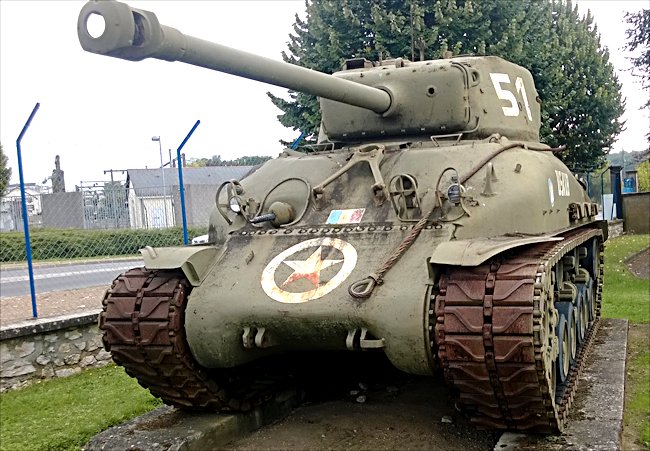
Free French Sherman Tank M4A1E8 76mm with wider tracked HVSS Horizontal Volute Spring Suspension
The Horizontal Volute Spring Suspension (HVSS) was designed to improve the shock absorbing action of the M4 Sherman tank. The tracks were widened from 16 inch (41 cm) to 23 inch (57.5 cm). The original bogie consisted in two lower track wheels and one track return wheel on top, the HVSS had four lower track wheels. The top return wheels were built on to the chassis. M4's with the HVSS system were called 'Easy Eight's' after the test vehicles, E8. This tank is fitted with the wide steel Chevron track s designed to give extra gripo in muddy and snowy conditions.
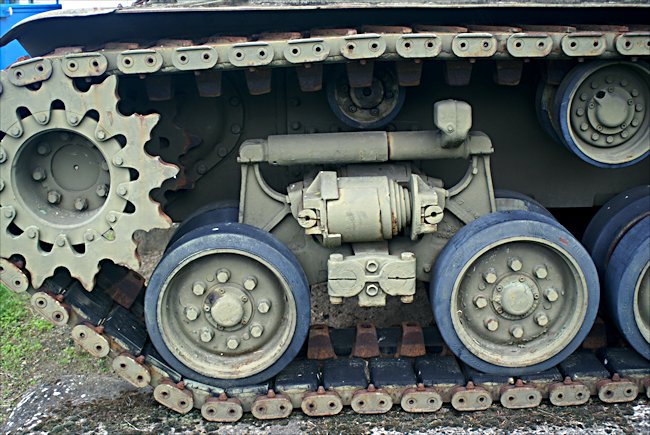
HVSS Horizontal Volute Spring Suspension had four wheels not two per unit.
Canadian Sherman tanks in Italy 1944-45
In the beginning of September 1944, after the Canadians had smashed their way through the supposedly invincible German defensive Gothic line that crossed from coast to coast on the Italian mainland just north of the Foglia Valley, they thought the war with the retreating Germans was nearly over. They assumed that the Germans were about to abandon all of Italy. This was far from the truth. In fact German reinforcements from other areas of northern Italy were rushing to breach the gap to keep the Allies from breaking into the river Po valley. They were intent on setting up a new line of defence around a place called Coriano a few miles inland in the foothills from the Adriatic sea south east of Rimini.
They knew the Allies were going to push along the relative flat land that skits the Adriatic coastline northwards. The hill top town of Coriano was on a ridge that effectively barred the Allies advance. German artillery observers could see any troop or tank movement below them. The steep sides of the ridge made this location an excellent defensive site.
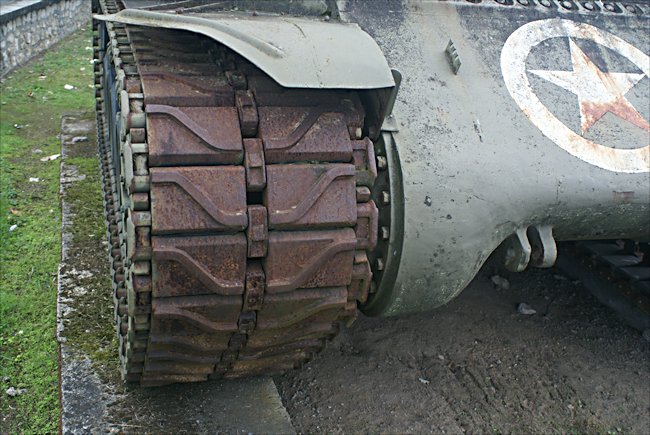
This is a close up of the wide steel cheveron track used on the Sherman Tank M4A1E8
The Allies’ intelligence believed that the town was lightly defended. This was a long way from the truth. They knew that they had to gain control of the village before the big push could start. Among the defenders were the highly motivated German 1st Parachute division who seemed to never give up a position. As soon as the Canadian Sherman tanks assigned to take control of the town, were in range, the artillery observers gave the order to fire. Sergeant Hans Bender was an artillery observer with the 11th Company of the 1st Parachute division, "I had to radio operators with me. All of a sudden we heard a shout, tanks from the front. I looked through the range finder and counted fifty tanks. After we had given an order by radio, it took about ten minutes for some artillery to arrive. The Canadian advance was totally exposed to the deadly fire of our guns. When the first ones caught on fire the others turned around".
Two Sherman tanks from B squadron of the 8th Hussars made a break for the bottom of the hill. But they got stuck in a dried up creek bed that formed a natural tank trap. The tanks of A squadron on the ridge gave covering fire and laid down a thick smoke screen which allowed the crews of the stranded tanks to escape. The Germans successfully stopped the Canadian attack of 4th September 1944.
On 13th September the Germans faced a second attack on Coriano ridge. The Canadians find that the defenders are intent on clinking on to their positions at all costs. Fifteen Canadian 8th Hussar Shermans manage to fight their way into the Coriano town square but they have fallen into an ambush of Tiger and Panzer IV tanks with supporting infantry amongst the rubble of blown up buildings. German Sergeant Hans Bender was there, "We would let them get close and then when we had a good shot we would fire". The Tiger tank advanced. The Sherman tank’s shells just bounced off the Tiger’s 100mm thick frontal armour.
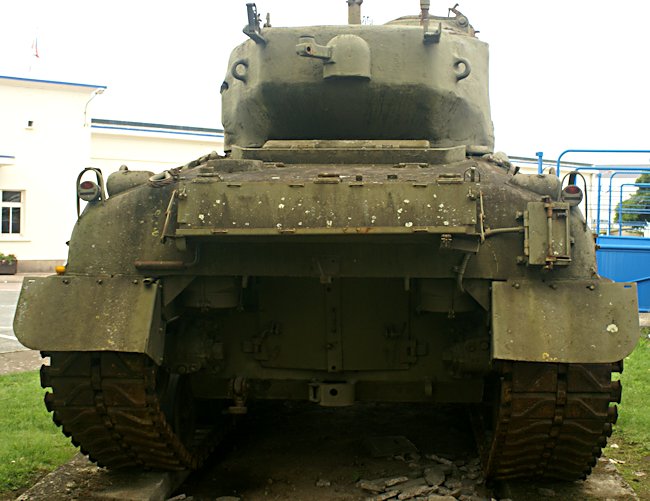
Free French Sherman Tank M4A1E8 76mm with wider tracked HVSS Horizontal Volute Spring Suspension
The other German tanks opened fire. There is a violent close quarter tank battle. A number of Canadian Sherman tanks are hit. In order to escape down the narrow streets they have to tow their wrecked tanks out of the way. The Canadians retreated out of the town and spent the rest of the day shelling the German positions from outside the town with the assistance of artillery.
The next morning the whole Canadian 5th Armoured Division regroups and goes back into Coriano. This time it was different. The German tanks had been wrecked by the constant bombardment of the previous day. After a day and night of fighting the town and the Coriano ridge were in Canadian hands.
The way for the lowland advance was now clear. The men called the Po valley the Promised Land. For the first time in the Italian campaign they thought they would be able to go into battle without the Germans looking down on them. Tankers had been dreaming of the day they could use their tank in a break out roll and chase the Germans back into the Alps. Unfortunately that was not going to be the case.
What the Allies did not realise was that the Germans desperate fight at the different defensive lines had a clear aim. The Germans were waiting for the bad weather of a northern Italian autumn and winter to arrive. The high water levels in rivers and the rain would be the Germans greatest friend in stopping the Allies advance. The Po valley is a tankers paradise in the summer dry weather but once the rivers and many irrigations ditches start to flood after heavy rains it is a nightmare. The mud get so deep in places that even tanks get stuck let alone fuel and ammunition supply trucks. September and October of 1944 were very wet months and the Po valley just filled up with water.
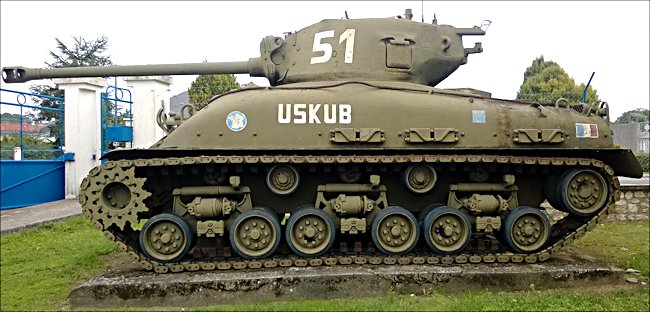
Free French Sherman Tank M4A1E8 76mm with wider tracked HVSS Horizontal Volute Spring Suspension
Any attempt to move off road meant that a 32 tonne Sherman tank would bog down to its axels immediately. Tanks started to become irrelevant in battle plans. They could not be used effectively. Deep mud made coordinated cross country tank attacks impossible. The germens dug in and the Allied advance slowed to a crawl. The stalemate lasted for almost two months.
It is not until the very end of 1944 do tanks again play a part in an off road role. The Italian winter arrived, temperatures dropped below zero and the mud and ground froze up. Tanks became mobile once more. The next task the Allies believed they had was to break out through the Po valley and chase retreating Germans back through the Alps. The problem was the Germans had no intention of evacuating Italy. They intended to fight for every inch of ground including a bulge in their line near Lake Commachnio by the town of Sant’ Alberto. The Canadians were going to have to move inland via the town of Conventello to avoid the lake. This made their right flank open to attack from troops in the bulge.
They had to be dealt with first before the general liberation of Italy drive in the spring of 1945 could go ahead. The battle for Lake Commachnio had the Allied objective of destroying all enemy opposition south of the lake. On 2nd of January 1945 the battle started. The 5th Canadian Armoured Division uses two of its tank regiments. They had delayed the attack until there had been two previous night of hard frost to make sure the ground had been frozen firm. They were gambling that the German anti-tank defences were only set up to defend the roads as over the past four months tanks had only been able to use the roads. The Canadian M4 Sherman tanks break out across the frozen fields. The tank’s tracks had all been fitted with "grousers". They extended the width of the Sherman’s tracks to help it travel over softer ground.
One of the advancing units suddenly came under fire from a previously unknown 88mm anti-tank unit and some Panther tanks hidden amongst some buildings. Some of the tanks were hit. Whilst the other tanks charged on Sergeant Daniel McKaskill acted quickly and stopped his tank. He ordered HE rounds to be loaded. He fired on the German 88mm guns who were preoccupied with the nearer advancing Shermans.
Because he was stationary he was able to have greater accuracy when returning fire than his colleagues on the move. He put himself and his crew at great danger because being stationary his tank was an easier target to hit. He single handily knocked out four enemy guns and with a very lucky shot he knocked out the Panther tank as well, whilst sustaining no damage himself.
With the Canadian 8th Hussar Shemans safely through this ambush zone, they continued onto Lake Commachnio, fighting their way through to the southern shore and into the town of Sant’ Alberto. They left the German defences in flames. They captured more than 600 prisoners and counted at least 300 dead. Lake Commachnio was the last big battle for the Canadians in the Italian campaign.
The whole action on the Italian main land was very successful in tying down some of the best formations in the Germany army and thus keeping them away from Normandy. Their job was not to win the war but to take the German strength out of Europe. The successful action in Italy came at a heavy price. 93,000 Canadians served in Italy. More than 20,000 were wounded and 6,000 died.
WW2 tank books

